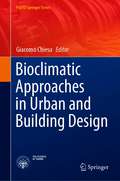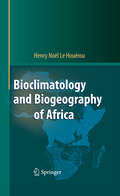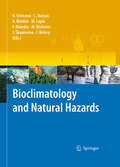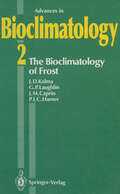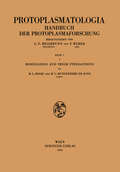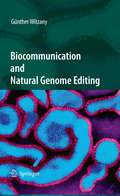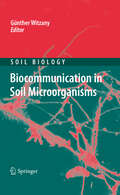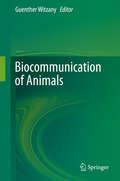- Table View
- List View
Biochemistry of Women Methods: For Clinical Investigation
by A.S. CurryThis book is written by experts who, using the latest techniques, describe laboratory investigations into women from conception to the grave. We asked the authors tp pay particular attention to the interpretation of laboratory results so we hope the book will be of interest to clinicians as well as to medical scientists.
Biochemistry of Zinc (Biochemistry of the Elements #11)
by Ananda S. PrasadIn response to the worldwide health problems caused by nutritional zinc deficiency, coupled with the remarkable advances in our knowledge of zinc metabolism, the author has written this monograph on the clinical effects of this important mineral. Dr. Prasad focuses on biochemical aspects, but also includes chapters on toxicity and assessment techniques in order to provide clinicians who encounter zinc related problems in their practice with a practical reference source.
Biochemistry (PDF)
by Jeremy M. Berg John L. Tymoczko Gregory J. Gatto Lubert StryerFor four decades, this extraordinary textbook played an pivotal role in the way biochemistry is taught, offering exceptionally clear writing, innovative graphics, coverage of the latest research techniques and advances, and a signature emphasis on physiological and medical relevance. Those defining features are at the heart of this edition. See what's in the LaunchPad
Biochemistry (PDF)
by Lubert Stryer Jeremy M. Berg John L. Tymoczko Gregory J. GattoDigital innovation and trusted authorship transform the way biochemistry students learn. The ninth edition of Biochemistry remains true to the integrity of the original Stryer text. Showcasing exceptionally clear writing, innovative graphics, coverage of the latest research techniques and advances, and a signature emphasis on physiological and medical relevance. Those defining features are at the heart of this edition. Biochemistry is now supported in Achieve, Macmillan's new online learning platform. Achieve is the culmination of years of development work put toward creating the most powerful online learning tool for chemistry students. Achieve includes an interactive eBook as well as our renowned assessments and innovative, interactive Metabolic Map. Students will be able to focus their study with adaptive quizzing and more clearly see the relevance of chemistry through case studies. Instructor resources, including tools for active learning are all housed in this exciting new platform. Achieve features a flexible suite of resources to support learning core concepts, visualization, problem-solving, and assessment. This powerful platform houses all student and instructor resources. You can assign what you want or download resources as you need. Powerful analytics and quick insights in Achieve pair with exceptional content to provide an unrivaled learning and teaching experience.
Biochemistry: A Very Short Introduction (Very Short Introductions)
by Mark LorchVery Short Introductions: Brilliant, Sharp, Inspiring From the simplest bacteria to humans, all living things are composed of cells of one type or another, all of which have fundamentally the same chemistry. This chemistry must provide mechanisms that allow cells to interact with the external world, a means to power the cell, machinery to carry out varied processes within the cell, a structure within which everything runs, and also governance through a web of interlocking chemical reactions. Biochemistry is the study of those reactions, the molecules that are created, manipulated, and destroyed as a result of them, and the massive macromolecules (such as DNA, cytoskeletons, proteins and carbohydrates) that form the chemical machinery and structures on which these biochemical reactions take place. It didn't take long for an understanding of the chemistry of life to turn into a desire to manipulate it. Drugs and therapies all aim to modify biochemical processes for good or ill: Penicillin, derived from mould, stops bacteria making their cell walls. Aspirin, with its origins in willow bark, inhibits enzymes involved in inflammatory responses. A few nanograms of botulinum toxin (botox), can kill by preventing the release of neurotransmitters from the ends of nerves and so leads to paralysis and death, or give a wrinkle free forehead (if administered in very tiny quantities).This Very Short Introduction discusses the key concepts of biochemistry, as well as the historical figures in the field and the molecules they studied, before considering the current science and innovations in the field, and the interaction between biochemistry, biotechnology, and synthetic biology. ABOUT THE SERIES: The Very Short Introductions series from Oxford University Press contains hundreds of titles in almost every subject area. These pocket-sized books are the perfect way to get ahead in a new subject quickly. Our expert authors combine facts, analysis, perspective, new ideas, and enthusiasm to make interesting and challenging topics highly readable.
Biochemistry: A Very Short Introduction (Very Short Introductions)
by Mark LorchVery Short Introductions: Brilliant, Sharp, Inspiring From the simplest bacteria to humans, all living things are composed of cells of one type or another, all of which have fundamentally the same chemistry. This chemistry must provide mechanisms that allow cells to interact with the external world, a means to power the cell, machinery to carry out varied processes within the cell, a structure within which everything runs, and also governance through a web of interlocking chemical reactions. Biochemistry is the study of those reactions, the molecules that are created, manipulated, and destroyed as a result of them, and the massive macromolecules (such as DNA, cytoskeletons, proteins and carbohydrates) that form the chemical machinery and structures on which these biochemical reactions take place. It didn't take long for an understanding of the chemistry of life to turn into a desire to manipulate it. Drugs and therapies all aim to modify biochemical processes for good or ill: Penicillin, derived from mould, stops bacteria making their cell walls. Aspirin, with its origins in willow bark, inhibits enzymes involved in inflammatory responses. A few nanograms of botulinum toxin (botox), can kill by preventing the release of neurotransmitters from the ends of nerves and so leads to paralysis and death, or give a wrinkle free forehead (if administered in very tiny quantities).This Very Short Introduction discusses the key concepts of biochemistry, as well as the historical figures in the field and the molecules they studied, before considering the current science and innovations in the field, and the interaction between biochemistry, biotechnology, and synthetic biology. ABOUT THE SERIES: The Very Short Introductions series from Oxford University Press contains hundreds of titles in almost every subject area. These pocket-sized books are the perfect way to get ahead in a new subject quickly. Our expert authors combine facts, analysis, perspective, new ideas, and enthusiasm to make interesting and challenging topics highly readable.
Biochips: Technology and Applications (Biological and Medical Physics, Biomedical Engineering)
by Wan-Li Xing Jing ChengThis book brings together contributions from internationally renowned experts in the biochip field. The authors present not only their latest research work, but also discuss current trends in biochip technology. Specific topics range from microarray technology and its applications to lab-on-a-chip technology.
Biochips and Medical Imaging
by Shan Xiang Wang Adam de la ZerdaAdvanced, recent developments in biochips and medical imaging Biochips and Medical Imaging is designed as a professional resource, covering recent biochip and medical imaging developments. Within the text, the authors encourage uniting aspects of engineering, biology, and medicine to facilitate advancements in the field of molecular diagnostics and imaging. Biochips are microchips for efficiently screening biological analytes. This book aims at presenting information on the state-of-the-art and emerging biosensors, biochips, and imaging devices of the body&’s systems, including the endocrine, circulatory, and immune systems. Medical diagnostics includes biochips (in-vitro diagnostics) and medical and molecular imaging (in-vivo imaging). Biochips and Medical Imaging explores the role of in-vitro and in-vivo diagnostics. It enables an instructor to share in-depth examples of the use of biochips in diagnosing cancer and cardiovascular diseases. Provides real-life knowledge on biochips and medical imaging, written by leading researchers Serves as a resource for professionals working in the biochip or imaging fields Features an accessible approach for anyone interested in biochips and their applications Readers of Biochips and Medical Imaging can expand their knowledge of medical technology, even if they have no biological knowledge and a limited math background. With its focus on important developments, this book is sure to also capture the interest of bioengineering and biomaterials scientists, structural biologists, electrical engineers, and nanotechnologists.
Biochips and Medical Imaging
by Shan Xiang Wang Adam de la ZerdaAdvanced, recent developments in biochips and medical imaging Biochips and Medical Imaging is designed as a professional resource, covering recent biochip and medical imaging developments. Within the text, the authors encourage uniting aspects of engineering, biology, and medicine to facilitate advancements in the field of molecular diagnostics and imaging. Biochips are microchips for efficiently screening biological analytes. This book aims at presenting information on the state-of-the-art and emerging biosensors, biochips, and imaging devices of the body&’s systems, including the endocrine, circulatory, and immune systems. Medical diagnostics includes biochips (in-vitro diagnostics) and medical and molecular imaging (in-vivo imaging). Biochips and Medical Imaging explores the role of in-vitro and in-vivo diagnostics. It enables an instructor to share in-depth examples of the use of biochips in diagnosing cancer and cardiovascular diseases. Provides real-life knowledge on biochips and medical imaging, written by leading researchers Serves as a resource for professionals working in the biochip or imaging fields Features an accessible approach for anyone interested in biochips and their applications Readers of Biochips and Medical Imaging can expand their knowledge of medical technology, even if they have no biological knowledge and a limited math background. With its focus on important developments, this book is sure to also capture the interest of bioengineering and biomaterials scientists, structural biologists, electrical engineers, and nanotechnologists.
Biochirality: Origins, Evolution and Molecular Recognition (Topics in Current Chemistry #333)
by Pedro CintasEarly History of the Recognition of Molecular Biochirality, by Joseph Gal, Pedro CintasSynthesis and Chirality of Amino Acids Under Interstellar Conditions, by Chaitanya Giri, Fred Goesmann, Cornelia Meinert, Amanda C. Evans, Uwe J. MeierhenrichChemical and Physical Models for the Emergence of Biological Homochirality, by son E. Hein, Dragos Gherase, Donna G. Blackmond Biomolecules at Interfaces: Chiral, Naturally, by Arántzazu González-Campo and David B. Amabilino Stochastic Mirror Symmetry Breaking: Theoretical Models and Simulation of Experiments, by Celia Blanco, David Hochberg Self-Assembly of Dendritic Dipeptides as a Model of Chiral Selection in Primitive Biological Systems, by Brad M. Rosen, Cécile Roche, Virgil Percec Chirality and Protein Biosynthesis, by Sindrila Dutta Banik, Nilashis Nandi
Bioclimatic Approaches in Urban and Building Design (PoliTO Springer Series)
by Giacomo ChiesaThis book explores the bioclimatic approach to building design. Constant innovations in the field are evident, including the need to face climate changes and increase the local resilience at different scales (regional, urban, architectural). Differently from other contributions, this book provides a definition of the bioclimatic design approach following a technological and performance-driven vision. It includes one of the largest collection of research voices on the topic, becoming also a critical reference work for bioclimatic theory. It is intended for architects, engineers, researchers, and technicians who have professional and research interests in bioclimatic and in sustainable and technological design issues.
Bioclimatic Architecture in Warm Climates: A Guide for Best Practices in Africa
by Manuel Correia Guedes Gustavo CantuariaThis book provides a comprehensive, hands-on approach to bioclimatic building design in Africa. Bioclimatic design is at the core of urban sustainability, and is a critical issue in Africa, where “imported” building typologies are being used at an increasing pace, disregarding the local context and consequently causing damage to the environment, to the economy, and to the culture itself. This book provides a concise set of sustainable design guidelines to be applied in both new buildings and the refurbishment of old buildings, and integrates bioclimatic design strategies with other sustainability issues such as: cultural aspects, affordability, and urban planning. Chapters are fully illustrated with photographs and drawings and include best-practice examples and strategies making it accessible to engineers, architects, students and a broad range of professionals in the building industry. Encompasses all climatic regions in Africa;Integrates bioclimatic design strategies with other sustainability issues;Discusses new design to refurbishment, from urban to rural, including office buildings, residential, tourism, social housing and self building.
Bioclimatology and Biogeography of Africa
by Henry N. HouérouCovering an area of over 130 million km2 spanning the Mediterranean, equator and tropics, the African continent features a spectacular geographic diversity. Consequently, it is characterised by extremely variable climatic, edaphic and ecological conditions, associated with a wide range of natural vegetation and wildlife, as well as human population density, crops and livestock. In this book, Henry Le Houérou presents his bioclimatic and biogeographic classification of Africa. The extensive data provide the basis for comparisons between various African regions, and with regions on other continents such as Latin America or the Indian subcontinent. The results constitute a rational basis for national, regional and sub-regional rural development planning, and for agricultural research dealing with aspects such as plant and animal introductions, the extrapolation or interpolation of experimental or developmental findings, and ecosystems dynamics. Possible problems of applications are also examined.
Bioclimatology and Natural Hazards
by Katarína Strelcová Miroslav Blazenec Jan Holecy Axel Kleidon Milan Lapin Frantisek Matejka Csaba Matyas Jaroslav SkvareninaAnthropogenic influences to the earth's system, including the atmosphere, hydrosphere, biosphere, cryosphere and lithosphere, represent a serious challenge to our planet's ecosystems and natural environments. Bioclimatology, hydrology, bio-hydrology and eco-physiology are important scientific research areas with wide application to environmental protection, forestry, agriculture and water management, and protection against natural hazards including droughts, floods, windstorms, weather extremes, and wild fires. Bioclimatology helps to better understand the causes and impacts of natural hazards and how to prevent them. Improved knowledge of natural hazards is a vital prerequisite for the implementation of integrated resource management. It provides a useful framework for combating current climate variability and for adapting to ongoing climate change. This book presents research on the interactions between meteorological, climatological, hydrological and biological processes in the atmospheric and terrestrial environment. It highlights a spectrum of topics associated with climate change and weather extremes and their impact on different economic sectors. The contributing authors come from renowned scientific research institutions and universities and specialise in issues of climate change, soil-plant-atmosphere interactions, hydrologic cycle, ecosystems, biosphere, and natural hazards.
The Bioclimatology of Frost: Its Occurrence, Impact and Protection (Advances in Bioclimatology #2)
by J. D. Kalma G. P. Laughlin J. M. Caprio P.J.C. HamerThe economic costs of frosts in agriculture and horticulture in many parts of the world can be very significant. Reports in the media include accounts on how frosts have devastated coffee crops in Brazil or in Papua New Guinea, and how frosts have seriously damaged the Florida citrus industry. Frost may cause losses in current harvests or a decline in future yields through more permanent damage to trees and bushes. Damaging frosts may occur as infrequent, short-term events with sub-zero temperatures or with unusually severe winter temperatures which extend over long periods. In this book we have aimed at providing a comprehensive review of recent advances in the area of frost research. The stimulus for writing this book has come from the recognition that there is a shortage of recent texts which deal exclusively with the bioclimatology of frost. Bioclimatology deals with the relations between climate and life and the present text is particularly concerned with the effects of low temperatures on plants. Our purpose has been to assist researchers, engineers, extension officers and students in understanding the physical aspects of frost occurrence and frost distribution as well as the biological and phenological aspects of frost damage and to provide an overview of direct and indirect methods of frost pro tection and prevention.
Biocoating for Fertilizer Industry (SpringerBriefs in Applied Sciences and Technology)
by Husnul Azan Tajarudin Charles Wai NgThis book presents the advancement of coating materials technology especially in agriculture, particularly for fertilizers. Fertilizers are a critical component in meeting rising demands and ensuring global food security. A new generation of fertilizers made by coating granules with biopolymers address these issues. Coating in agriculture is an important area in research for a more sustainable future. Many examples and instances from existing research and related research gaps are discussed. It includes applications of composites as fertilizer’s coating, advantages and disadvantages of fertilizer coating from composites, applications of bacteria in composite, applications of bacteria in fertilizer industry as well as the common techniques of coating fertilizers with drying process.
Biocode: The New Age of Genomics
by Dawn Field Neil DaviesThe living world runs on genomic software - what Dawn Field and Neil Davies call the 'biocode' - the sum of all DNA on Earth. In Biocode, they tell the story of a new age of scientific discovery: the growing global effort to read and map the biocode, and what that might mean for the future. The structure of DNA was identified in 1953, and the whole human genome was mapped by 2003. Since then the new field of genomics has mushroomed and is now operating on an industrial scale. Genomes can now be sequenced rapidly and increasingly cheaply. The genomes of large numbers of organisms from mammals to microbes, have been mapped. Getting your genome sequenced is becoming affordable for many. You too can check paternity, find out where your ancestors came from, or whether you are at risk of some diseases. Some check out the pedigree of their pets, while others turn genomes into art. A stray hair is enough to crudely reconstruct the face of the owner. From reading to constructing: the first steps to creating artificial life have already been taken. Some may find the rapidity of developments, and the potential for misuse, alarming. But they also open up unprecedented possibilities. The ability to read DNA has changed how we view ourselves and understand our place in nature. From the largest oceans, to the insides of our guts, we are able to explore the biosphere as never before, from the genome up. Sequencing technology has made the invisible world of microbes visible, and biodiversity genomics is revealing whole new worlds within us and without. The findings are transformational: we are all ecosystems now. Already the first efforts at 'barcoding' entire ecological communities and creating 'genomic observatories' have begun. The future, the authors argue, will involve biocoding the entire planet.
Biocolloids and their Interactions: With Special Reference to Coacervates and Related Systems (Protoplasmatologia Cell Biology Monographs #1 / 2)
by Heinerle L. Booij Hendrik G. Bungenberg de JongBiocombinatorial Approaches for Drug Finding (Ernst Schering Foundation Symposium Proceedings #51)
by W. Wohlleben T. Spellig B. Müller-TiemannGenome- and proteome-based research is generating a significant increase in the number of available drug targets. Correspondingly there is an increasing need for novel, diverse compounds, particularly based on natural compounds, as screening resource. The purpose of the Ernst Schering Research Foundation Workshop 51 was to provide a forum for an open exchange on perspectives and limitations of biocombinatorial synthesis and the significance of this technology for future drug discovery in light of this challenge. Experts from academia and industry provided contributions covering: the significance of natural compounds for state-of-the-art drug discovery; the underlying basic principle for the biosynthesis of highly complex compounds; and the scope and limitations of combinatorial biosynthesis regarding formation, identification, optimisation, isolation and manufacturing of novel biologically active entities.
Biocommunication and Natural Genome Editing
by Günther WitzanyI wrote this book for biologists and those who are interested in both biological affairs in general and perspectives which integrate a large number of specialised biological disciplines. The theory of biocommunication presented herein investigates signal transd- tion processes among cells, tissues, organs and organisms in bacteria, animals (corals and bees), fungi and plants in the light of the current available empirical data. Because life is the central focus of the life sciences, this theory will also focus on typical features of life as opposed to inorganic matter. Because this eld of investigation is based on the methodological primacy of a pragmatic action theory, the book may also be of interest to researchers of lingu- tics, communication sciences and sociology (e.g. plant sociology, animal sociology) who would welcome an overview of these highly specialised biological disciplines. Current molecular biology as well as cell biology investigates its scienti c object by using key terms such as genetic code, code without commas, misre- ing of the genetic code, coding, open reading frame, genetic storage medium DNA, genetic information, genetic alphabet, genetic expression, messenger RNA, ce- to-cell communication, immune response, transcription, translation, nucleic acid language, amino acid language, recognition sequences, recognition sites, protein coding sequences, repeat sequences, signalling, signal transduction, signalling codes, signalling pathways, etc.
Biocommunication in Soil Microorganisms (Soil Biology #23)
by Günther WitzanyCommunication is defined as an interaction between at least two living agents which share a repertoire of signs. These are combined according to syntactic, semantic and context-dependent, pragmatic rules in order to coordinate behavior. This volume deals with the important roles of soil bacteria in parasitic and symbiotic interactions with viruses, plants, animals and fungi. Starting with a general overview of the key levels of communication between bacteria, further reviews examine the various aspects of intracellular as well as intercellular biocommunication between soil microorganisms. This includes the various levels of biocommunication between phages and bacteria, between soil algae and bacteria, and between bacteria, fungi and plants in the rhizosphere, the role of plasmids and transposons, horizontal gene transfer, quorum sensing and quorum quenching, bacterial-host cohabitation, phage-mediated genetic exchange and soil viral ecology.
Biocommunication of Animals
by Guenther WitzanyEvery coordination within or between animals depends on communication processes. Although the signaling molecules, vocal and tactile signs, gestures and its combinations differ throughout all species according their evolutionary origins and variety of adaptation processes, certain levels of biocommunication can be found in all animal species: (a) Abiotic environmental indices such as temperature, light, water, etc. that affect the local ecosphere of an organism and are sensed, interpreted. (b) Trans-specific communication with non-related organisms.(c) Species-specific communication between same or related species. (d) Intraorganismic communication, i.e., sign-mediated coordination within the body of the organism. This book gives an overview of the manifold levels of animal communication exemplified by a variety of species and thereby broadens the understanding of these organisms.
Biocommunication of Archaea
by Guenther WitzanyArchaea represent a third domain of life with unique properties not found in the other domains. Archaea actively compete for environmental resources. They perceive themselves and can distinguish between ‘self’ and ‘non-self’. They process and evaluate available information and then modify their behaviour accordingly. They assess their surroundings, estimate how much energy they need for particular goals, and then realize the optimum variant. These highly diverse competences show us that this is possible owing to sign(aling)- mediated communication processes within archaeal cells (intra-organismic), between the same, related and different archaeal species (interorganismic), and between archaea and nonarchaeal organisms (transorganismic). This is crucial in coordinating growth and development, shape and dynamics. Such communication must function both on the local level and between widely separated colony parts. This allows archaea to coordinate appropriate response behaviors in a differentiated manner to their current developmental status and physiological influences. This book will orientate further investigations on how archaeal ecosphere inhabitants communicate with each other to coordinate their behavioral patterns and whats the role of viruses in this highly dynamic interactional networks.
Biocommunication of Ciliates
by Guenther Witzany Mariusz NowackiThis is the first coherent description of all levels of communication of ciliates. Ciliates are highly sensitive organisms that actively compete for environmental resources. They assess their surroundings, estimate how much energy they need for particular goals, and then realise the optimum variant. They take measures to control certain environmental resources. They perceive themselves and can distinguish between ‘self’ and ‘non-self’. They process and evaluate information and then modify their behaviour accordingly. These highly diverse competences show us that this is possible owing to sign(aling)-mediated communication processes within ciliates (intra-organismic), between the same, related and different ciliate species (inter-organismic), and between ciliates and non-ciliate organisms (trans-organismic). This is crucial in coordinating growth and development, shape and dynamics.This book further serves as a learning tool for research aspects in biocommunication in ciliates. It will guide scientists in further investigations on ciliate behavior, how they mediate signaling processes between themselves and the environment.









